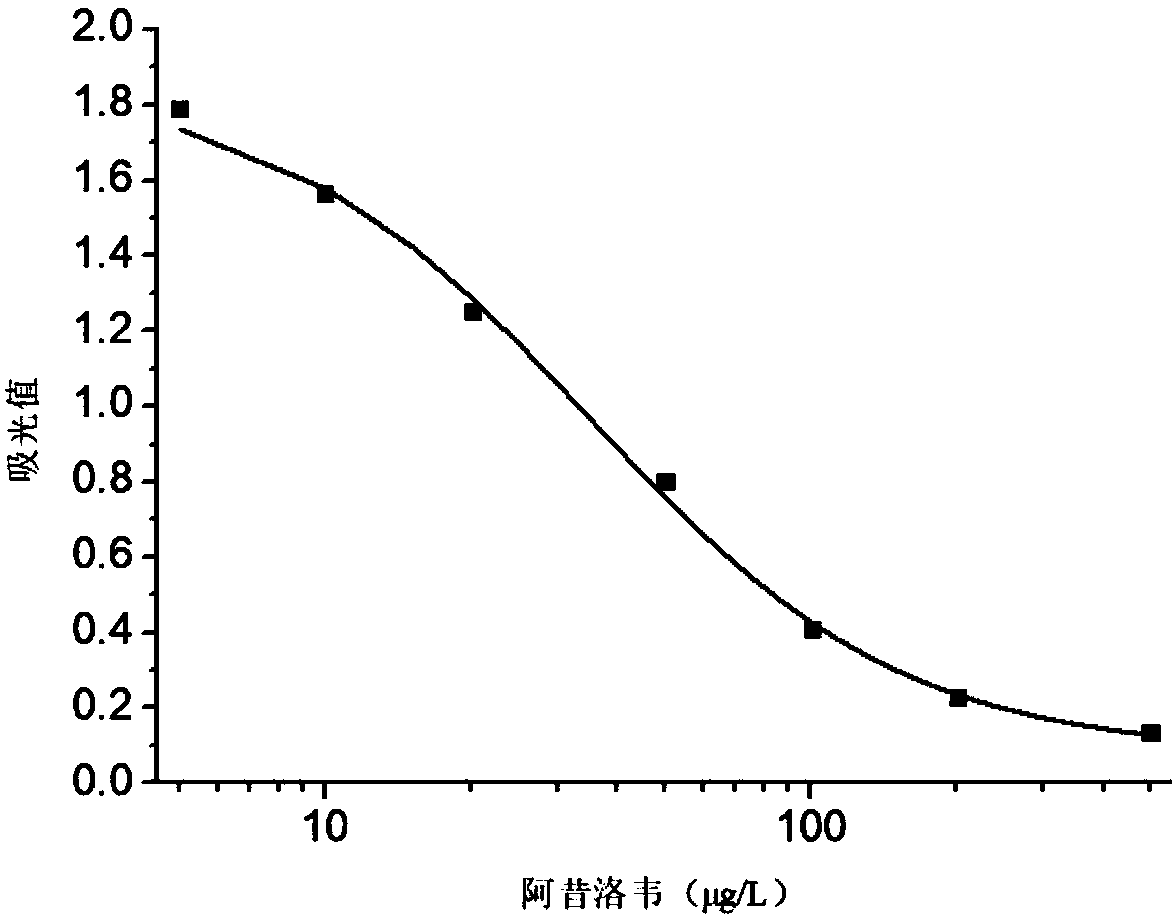Hybridoma cell strain secreting acyclovir monoclonal antibody and preparation method
A technology of hybridoma cell lines and monoclonal antibodies, which is applied in botany equipment and methods, biochemical equipment and methods, cells modified by introducing foreign genetic material, etc. Problems such as complex components of Lowe and low content of target substances, to achieve good detection sensitivity and specificity
- Summary
- Abstract
- Description
- Claims
- Application Information
AI Technical Summary
Problems solved by technology
Method used
Image
Examples
Embodiment 1
[0038] Embodiment 1: the synthesis of complete antigen of acyclovir
[0039] Take 4 mg of acyclovir, add 30 μL of 5% glutaraldehyde aqueous solution, stir at room temperature, and activate for 10 min; another 10 mg of BSA (bovine serum albumin) is dissolved in 2 mL of 0.05 M, pH 9.6 CB (carbonate buffer solution ) solution, the above activation solution was added dropwise to the KLH solution, stirred at room temperature for 1.5 hours, dialyzed at 4°C for three days, and stored at -20°C. (The ultraviolet characterization effect of the complete antigen of acyclovir is as follows figure 1 )
Embodiment 2
[0040] Embodiment 2: the preparation of the hybridoma cell line that secretes acyclovir monoclonal antibody
[0041] 1. Acquisition of animal immunity
[0042]Select healthy 6-8 week-old Balb / C mice for immunization, mix the obtained acyclovir complete antigen with an equal amount of oil, and then add emulsifier to obtain incomplete Freund's adjuvant after emulsification. Complete Freund's adjuvant was obtained by adding mycobacteria into complete Freund's adjuvant; the obtained Freund's adjuvant was subcutaneously injected in the back to immunize BALB / c mice for several times, and the complete Freund's adjuvant was used for the first immunization, and then Two times of booster immunization with incomplete Freund's adjuvant; on the 7th day after the end of the three times of immunization, blood was collected from the mice, and the immune titer and immunosuppressive ability of the mouse serum were detected by indirect ELISA, and the abcicilin in the serum was deleted. The immu...
Embodiment 3
[0053] Example 3: Preparation and Identification of Acyclovir Monoclonal Antibody
[0054] Take 8-10 week-old BALB / c mice, and inject 1 mL of paraffin oil into each mouse; 7 days later, each mouse is injected with 1×10 6 For the hybridoma cells secreting acyclovir monoclonal antibody, the ascites was collected from the seventh day, and the ascites was purified by octanoic acid-ammonium sulfate method, and the obtained monoclonal antibody was stored at -20°C.
[0055] The mouse monoclonal antibody subtype identification kit was used to identify the immunoglobulin subtype of the monoclonal antibody purified from ascitic fluid, and the subtype was IgG2b. (The subtype identification results of monoclonal antibodies are shown in Table 1)
[0056] Using indirect competition ELISA, the IC50 of the monoclonal antibody acyclovir was determined to be 35 μg / L, indicating that it has good sensitivity to acyclovir and can be used for acyclovir immunoassay detection.
PUM
 Login to View More
Login to View More Abstract
Description
Claims
Application Information
 Login to View More
Login to View More - R&D
- Intellectual Property
- Life Sciences
- Materials
- Tech Scout
- Unparalleled Data Quality
- Higher Quality Content
- 60% Fewer Hallucinations
Browse by: Latest US Patents, China's latest patents, Technical Efficacy Thesaurus, Application Domain, Technology Topic, Popular Technical Reports.
© 2025 PatSnap. All rights reserved.Legal|Privacy policy|Modern Slavery Act Transparency Statement|Sitemap|About US| Contact US: help@patsnap.com


